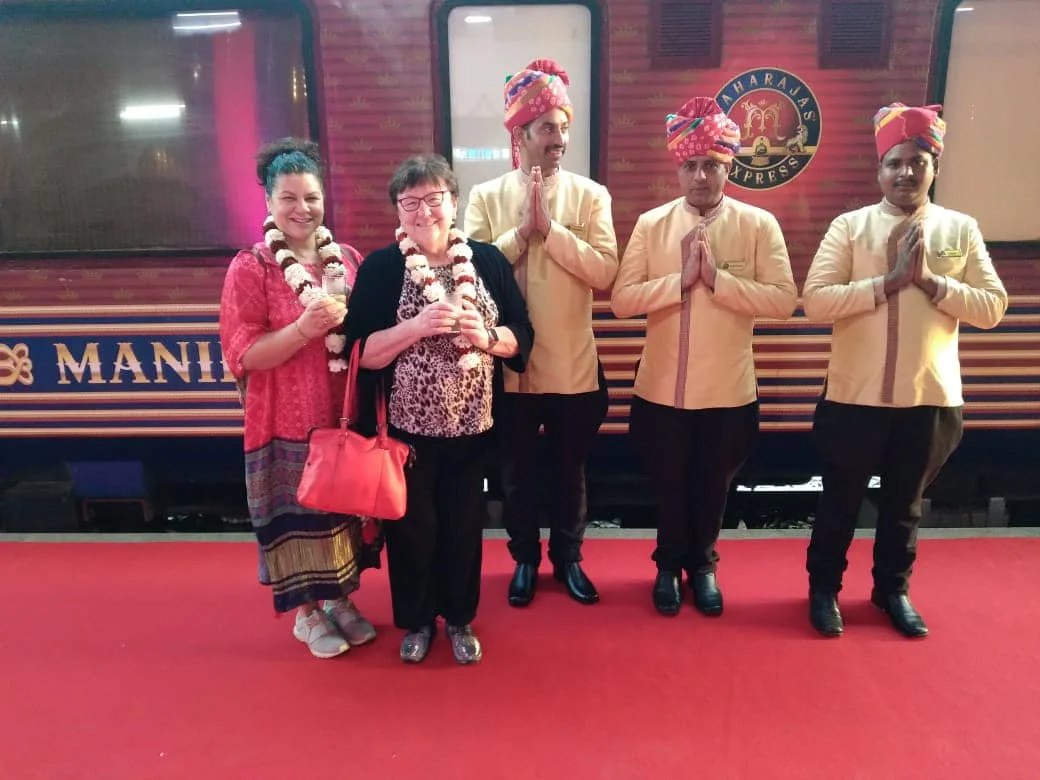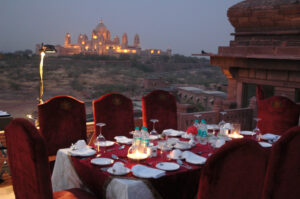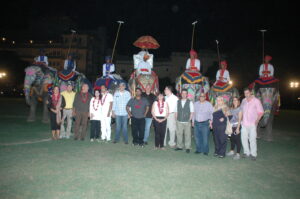The Maharaja Express isn’t just a train; it’s an experience that redefines the concept of luxury travel. This opulent train, often compared to royal carriages of yore, offers an unrivaled journey through India’s rich tapestry of culture, history, and landscapes. Among its various meticulously designed routes, the Indian Panorama stands out as a quintessential exploration of India’s heartland. This route unveils the grandeur of India’s cultural heritage, from majestic forts and palaces to sacred temples and vibrant cities.
 The Journey Begins: Stepping Aboard the Maharaja Express
The Journey Begins: Stepping Aboard the Maharaja Express
A Glimpse of Royalty
The moment you step aboard the Maharaja Express, you’re transported into an era of regal splendor. The train is a seamless blend of classical elegance and modern sophistication, designed to emulate the grandeur of the Maharajas who once ruled India. Each of the 14 guest carriages, named after precious gemstones, is adorned with rich tapestries, intricate carvings, and luxurious furnishings that exude a sense of timeless opulence.
Lavish Accommodations
The Maharaja Express offers four types of suites: Deluxe Cabin, Junior Suite, Suite, and the grand Presidential Suite, each equipped with state-of-the-art amenities. The Presidential Suite, spanning an entire carriage, is the epitome of luxury on rails, featuring a living room, a master bedroom, and a bathroom with a bathtub. Every detail, from the hand-woven linens to the plush bedding, ensures a journey steeped in comfort and elegance.
Gourmet Dining
Dining aboard the Maharaja Express is nothing short of a royal feast. The train boasts two exquisitely decorated dining cars – the Mayur Mahal and the Rang Mahal – where master chefs curate a menu that spans global and Indian cuisines. Meals are prepared with the finest ingredients and are served on fine bone china with silver cutlery, reminiscent of royal banquets. Whether it’s a traditional Rajasthani thali or a continental delicacy, each dish is a culinary masterpiece.
 The Indian Panorama Route: An Exquisite Expedition
The Indian Panorama Route: An Exquisite Expedition
Day 1: Delhi – The Capital’s Grandeur
The Indian Panorama route begins in the bustling capital city of Delhi. A city where history and modernity coexist, Delhi offers a vibrant start to the journey. The train departs from the Safdarjung Railway Station, and guests are greeted with a grand welcome that sets the tone for the journey ahead.
 Day 2: Jaipur – The Pink City’s Majesty
Day 2: Jaipur – The Pink City’s Majesty
On the second day, the Maharaja Express rolls into Jaipur, the Pink City. Jaipur, with its magnificent forts, palaces, and vibrant bazaars, is a gateway to Rajasthan’s royal heritage. The day’s excursion includes a visit to the Amber Fort, a stunning example of Rajput architecture, and a chance to experience an elephant ride up the ramparts. The City Palace, Jantar Mantar, and Hawa Mahal are other highlights of the day, offering insights into the grandeur of Jaipur’s royal past.
Amber Fort: A Gem of Rajput Architecture
Perched on a hilltop, the Amber Fort is a masterpiece of Rajput architecture. The fort’s stunning blend of Hindu and Mughal styles is evident in its intricate carvings, vast courtyards, and the beautiful Sheesh Mahal, or Hall of Mirrors. The sound and light show at the fort is a mesmerizing experience, recounting the history of the Kachwaha rulers in a spectacular fashion.
City Palace: The Royal Residence
The City Palace of Jaipur is a sprawling complex that showcases a blend of Mughal and Rajput architecture. Within its confines, the museum houses an extensive collection of royal costumes, armory, and manuscripts, offering a glimpse into the opulent lifestyle of Jaipur’s rulers.
 Day 3: Ranthambore – Wilderness and Royalty
Day 3: Ranthambore – Wilderness and Royalty
The third day takes you to the heart of India’s wilderness at Ranthambore National Park. Once the hunting grounds of the Maharajas of Jaipur, this park is now a thriving wildlife sanctuary. The highlight here is the thrilling safari, where you might catch a glimpse of the majestic Bengal tiger in its natural habitat. Ranthambore also houses the ancient Ranthambore Fort, a UNESCO World Heritage site, adding a historical dimension to the wilderness experience.
Ranthambore National Park: The Tiger’s Abode
Ranthambore is renowned for its population of Bengal tigers, and the chances of spotting one during a safari are high. The park is also home to a variety of other wildlife, including leopards, deer, and an array of bird species. The experience of watching a tiger prowling in the wild is one of the most thrilling moments of the journey.
Ranthambore Fort: A Historic Marvel
Overlooking the park, the Ranthambore Fort is a formidable structure with a history that dates back to the 10th century. The fort offers panoramic views of the surrounding landscape and is dotted with temples, palaces, and stepwells that speak of its historical significance.
 Day 4: Fatehpur Sikri and Agra – Mughal Magnificence
Day 4: Fatehpur Sikri and Agra – Mughal Magnificence
The fourth day of the journey is dedicated to the Mughal era’s architectural brilliance. The day begins with a visit to Fatehpur Sikri, a UNESCO World Heritage site, and continues to Agra, home to the iconic Taj Mahal.
Fatehpur Sikri: The Ghost City
Fatehpur Sikri, the erstwhile capital of the Mughal Empire, is an abandoned city that tells tales of its short-lived glory. Built by Emperor Akbar in the 16th century, the city is an architectural marvel with its red sandstone palaces, courtyards, and mosques. The Buland Darwaza, the grand entrance to the city, is one of the most imposing structures of its kind.
Agra: The Epitome of Love
Agra is synonymous with the Taj Mahal, the world-renowned symbol of love. This white marble mausoleum, built by Emperor Shah Jahan in memory of his beloved wife Mumtaz Mahal, is a masterpiece of Mughal architecture. The intricate inlay work, the symmetry, and the sheer beauty of the Taj Mahal make it a sight to behold, especially at sunrise when the first rays of the sun cast a golden hue on the marble.
 Day 5: Orchha and Khajuraho – Temples of Intrigue
Day 5: Orchha and Khajuraho – Temples of Intrigue
On the fifth day, the train reaches Orchha, a town steeped in medieval charm, and then proceeds to Khajuraho, famous for its UNESCO-listed temples adorned with intricate erotic sculptures.
Orchha: A Medieval Marvel
Orchha, once the capital of the Bundela Rajputs, is a town where time seems to have stood still. The town’s grandeur is reflected in its palaces, temples, and cenotaphs, all of which are beautifully preserved. The Orchha Fort complex, with its Raja Mahal and Jahangir Mahal, offers a glimpse into the architectural prowess of the Bundela rulers.
Khajuraho: Erotic Sculptures and Spiritual Splendor
The temples of Khajuraho are a UNESCO World Heritage site, renowned for their exquisite sculptures that depict various aspects of life, including eroticism, which is intricately interwoven with spirituality. Built between the 9th and 11th centuries by the Chandela dynasty, these temples are a testament to India’s rich artistic heritage. The Western Group of Temples, including the Kandariya Mahadeva Temple, is the most famous for its stunning architectural design and detailed carvings.
 Day 6: Varanasi – The Spiritual Soul of India
Day 6: Varanasi – The Spiritual Soul of India
The penultimate day of the Indian Panorama journey is spent in Varanasi, the spiritual heart of India. This ancient city, situated on the banks of the sacred Ganges River, is a place where spirituality and daily life are intricately linked.
The Ghats of Varanasi: A Sacred Ritual
Varanasi’s ghats are the focal point of life in the city. Here, pilgrims perform rituals, meditate, and offer prayers, while sadhus (holy men) chant and meditate. The evening Ganga Aarti at Dashashwamedh Ghat is a mesmerizing spectacle, where priests perform rituals with lit lamps, incense, and rhythmic chants, creating an atmosphere charged with spiritual energy.
Sarnath: The Buddhist Connection
A short drive from Varanasi is Sarnath, where Lord Buddha delivered his first sermon after attaining enlightenment. The site is of immense significance to Buddhists and houses several stupas, monasteries, and the iconic Ashoka Pillar.
 Day 7: Return to Delhi – Journey’s End
Day 7: Return to Delhi – Journey’s End
As the train rolls back into Delhi on the final day, guests reflect on the extraordinary journey they’ve just experienced. The Indian Panorama route of the Maharaja Express is not just a voyage through India’s diverse landscapes but also a journey through time, taking you from the ancient to the modern, the spiritual to the royal.
Conclusion: An Unforgettable Expedition
The Maharaja Express’s Indian Panorama route is an opulent odyssey through India’s most iconic destinations. It’s a journey that offers a unique blend of history, culture, nature, and luxury. Each stop on this route is a chapter in the grand narrative of India, with its own distinct flavor and story to tell.
For travelers seeking an experience that transcends the ordinary, the Maharaja Express offers a chance to explore India in a manner that is both luxurious and immersive. The Indian Panorama route, with its well-curated itinerary, ensures that guests not only witness the grandeur of India but do so in a style that befits royalty. From the splendor of Jaipur’s palaces to the spirituality of Varanasi’s ghats, this journey is a celebration of India’s timeless allure.
 Toll-Free 1-855-952-6526
Toll-Free 1-855-952-6526 +44 1753 201 201
+44 1753 201 201  61-2-86078986
61-2-86078986  + 44 ( 0 ) 7739 716978
+ 44 ( 0 ) 7739 716978 












